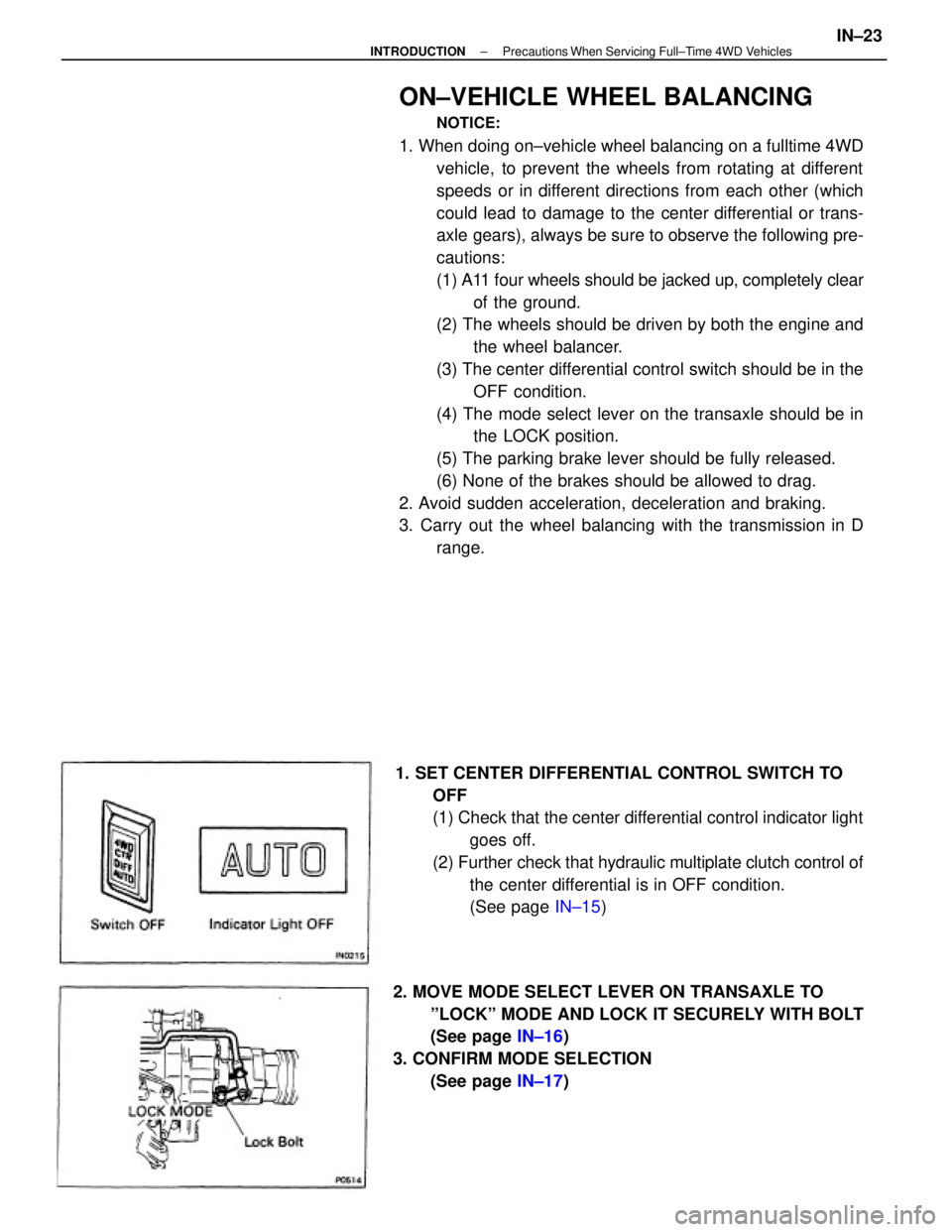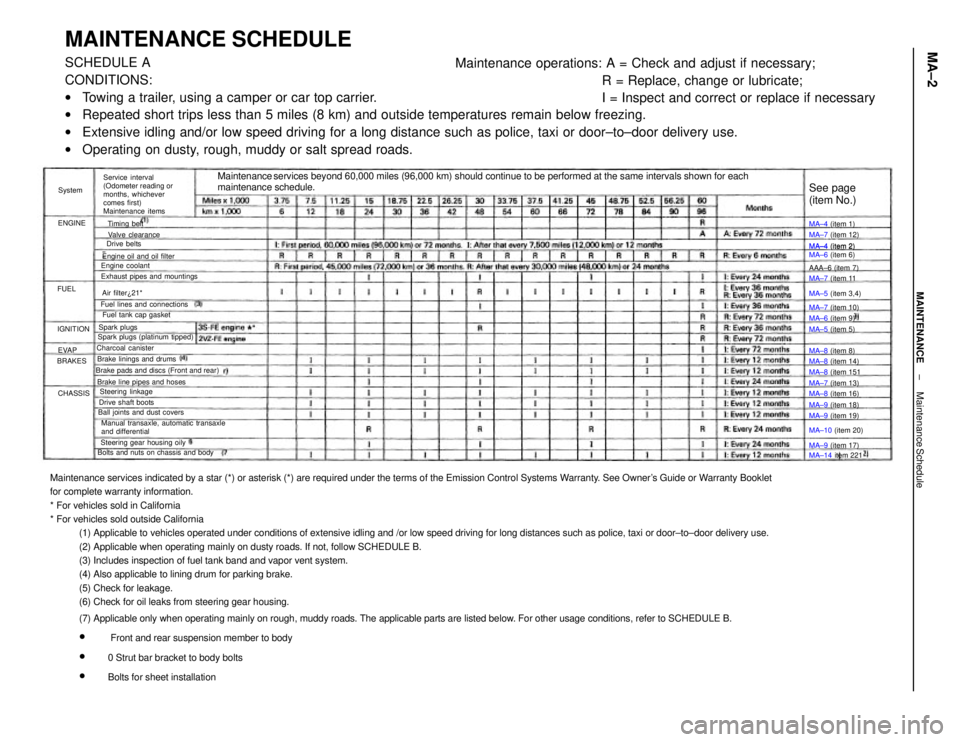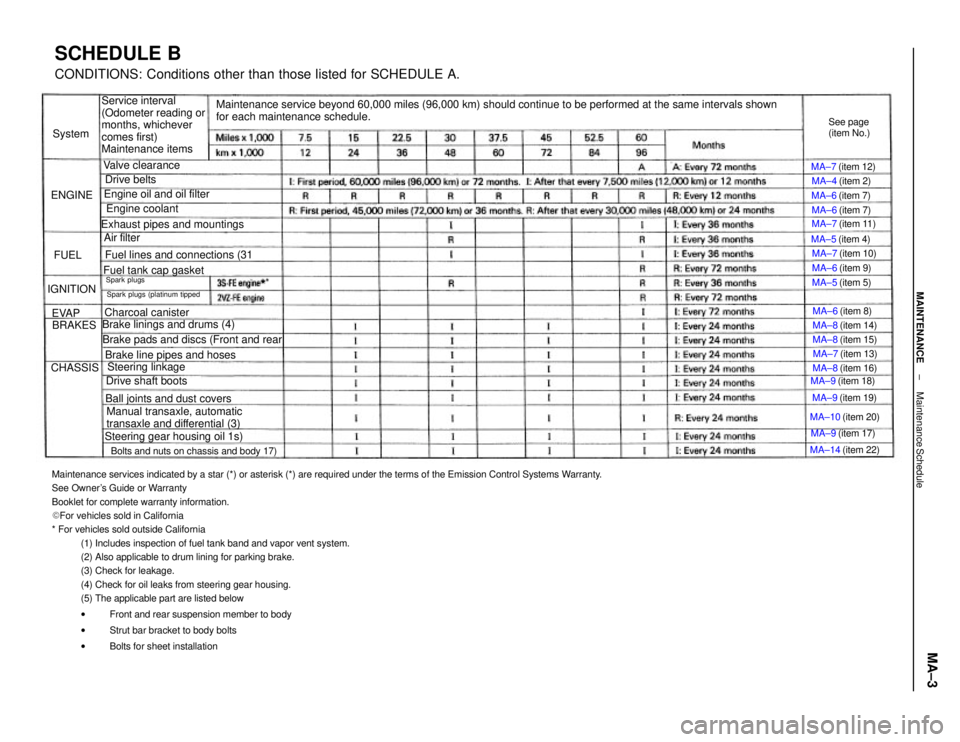Page 1877 of 2389
5. PLACE WHEELS (EITHER FRONT OR REAR) TO BE
TESTED ON TESTER ROLLERS
6. CHOCK OTHER WHEELS
7. DISCONNECT INERTIA WEIGHT FROM TESTER ROLL-
ER (if equipped with it)
8. PUT TRANSMISSION IN N RANGE
9. OPERATE TESTER ROLLERS AND MEASURE
BRAKING FORCE WITH ENGINE AT IDLE
HINT: Since different types of tester are used, such as
specialized brake testers and combination testers with
builtin chassis dynamometer, speedometer tester, brake test-
er, etc., conduct the test in accordance with the instructions
furnished for the tester in use.
10. AFTER FINISHING TEST, INSTAL! REAR PROPELLER
SHAFT
Align the matching marks made on the rear propeller shaft
before removal, then install it.
11. RETURN MODE SELECT LEVER TO ºFREE (NORMAL)º
MODE POSITION AND LOCK IT SECURELY WITH
BOLT
12. SET CENTER DIFFERENTIAL CONTROL SWITCH TO
AUTO
± INTRODUCTIONPrecautions When Servicing Full±Time 4WD VehiclesIN±20
Page 1878 of 2389
![TOYOTA CAMRY V20 1986 Service Information SPEEDOMETER TEST OR OTHER TESTS
[Using Speedometer Tester or Chassis Dynamometer]
1. SET CENTER DIFFERENTIAL CONTROL SWITCH TO
OFF
(1) Check that the center differential control indicator light
goes TOYOTA CAMRY V20 1986 Service Information SPEEDOMETER TEST OR OTHER TESTS
[Using Speedometer Tester or Chassis Dynamometer]
1. SET CENTER DIFFERENTIAL CONTROL SWITCH TO
OFF
(1) Check that the center differential control indicator light
goes](/manual-img/14/57449/w960_57449-1877.png)
SPEEDOMETER TEST OR OTHER TESTS
[Using Speedometer Tester or Chassis Dynamometer]
1. SET CENTER DIFFERENTIAL CONTROL SWITCH TO
OFF
(1) Check that the center differential control indicator light
goes oft.
(2) Further check that the operation of the hydraulic
multiplate clutch control of the center differential is in
OFF condition.
(See page IN±15)
2. MOVE MODE SELECT LEVER ON TRANSAXLE TO ºLOCKº
MODE AND LOCK IT SECURELY WITH BOLT (See page
IN±16)
3. CONFIRM MODE SELECTION
(See page IN±17)
8. DISCONNECT INERTIA WEIGHT FROM TESTER ROLL-
ER (If equipped with it)
9. TEST VEHICLE
(1) Start the engine.
(2) Put the transmission in D range, then gradually in-
crease the speed as the test in conducted.
(3) After the test is finished, reduce the speed gradually
and stop the engine. 4. REMOVE REAR PROPELLER SHAFT
Make matching marks on each end of the rear propeller
shaft, then remove it.
5. PLACE FRONT WHEELS ON TESTER ROLLERS
6. CHOCK REAR WHEELS
7. APPLY PARKING BRAKE
10. AFTER FINISHING TEST, INSTALL REAR PROPELLER
SHAFT
Align the matching marks made on the rear propeller shaft
before removal, then install it.
± INTRODUCTIONPrecautions When Servicing Full±Time 4WD VehiclesIN±21
Page 1880 of 2389

ON±VEHICLE WHEEL BALANCING
NOTICE:
1. When doing on±vehicle wheel balancing on a fulltime 4WD
vehicle, to prevent the wheels from rotating at different
speeds or in different directions from each other (which
could lead to damage to the center differential or trans-
axle gears), always be sure to observe the following pre-
cautions:
(1) A11 four wheels should be jacked up, completely clear
of the ground.
(2) The wheels should be driven by both the engine and
the wheel balancer.
(3) The center differential control switch should be in the
OFF condition.
(4) The mode select lever on the transaxle should be in
the LOCK position.
(5) The parking brake lever should be fully released.
(6) None of the brakes should be allowed to drag.
2. Avoid sudden acceleration, deceleration and braking.
3. Carry out the wheel balancing with the transmission in D
range.
1. SET CENTER DIFFERENTIAL CONTROL SWITCH TO
OFF
(1) Check that the center differential control indicator light
goes off.
(2) Further check that hydraulic multiplate clutch control of
the center differential is in OFF condition.
(See page IN±15)
2. MOVE MODE SELECT LEVER ON TRANSAXLE TO
ºLOCKº MODE AND LOCK IT SECURELY WITH BOLT
(See page IN±16)
3. CONFIRM MODE SELECTION
(See page IN±17)
± INTRODUCTIONPrecautions When Servicing Full±Time 4WD VehiclesIN±23
Page 1881 of 2389
4. JACK UP VEHICLE So THAT ALL FOUR WHEELS CAN
ROTATE
The wheels will be rotating fast, so make sure the vehicle is
firmly supported on stands.
7. PLACE WHEEL TO BE BALANCED ON WHEEL
BALANCER
Follow the procedure specified by the wheel balancer
manufacturer.
8. START ENGINE
9. PUT TRANSMISSION IN ºDº RANGE, THEN
GRADUALLY INCREASE SPEED TO TEST SPEED 6. MAKE SURE THAT BRAKES ARE NOT DRAGGING
ON ANY OF FOUR WHEELS 5. RELEASE PARKING BRAKE FULLY
± INTRODUCTIONPrecautions When Servicing Full±Time 4WD VehiclesIN±24
Page 1883 of 2389
![TOYOTA CAMRY V20 1986 Service Information PRECAUTIONS WHEN TOWING
FULL±TIME 4WD VEHICLES
1. Use one of the methods shown below to tow the vehicle.
2. When there is trouble with the chassis and drivetrain, use
method [1] (flat bed truck) or m TOYOTA CAMRY V20 1986 Service Information PRECAUTIONS WHEN TOWING
FULL±TIME 4WD VEHICLES
1. Use one of the methods shown below to tow the vehicle.
2. When there is trouble with the chassis and drivetrain, use
method [1] (flat bed truck) or m](/manual-img/14/57449/w960_57449-1882.png)
PRECAUTIONS WHEN TOWING
FULL±TIME 4WD VEHICLES
1. Use one of the methods shown below to tow the vehicle.
2. When there is trouble with the chassis and drivetrain, use
method [1] (flat bed truck) or method T (sling type tow
truck with doilies)
3. Recommended Methods: No. [1], [2], or [3]
Emergency Method: No. [4]
During towing with this towing method, there is a danger of the drivetrain
heating up and causing breakdown, or of the front wheels flying off the dolly.
HINT: Do not use any towing methods other than those shown above.
For example, the towing method shown below is dangerous, so do not use it
HINT: Do not tow the vehicle at a speed
faster than 18 mph (30 km/h) or a distance
greater than 50 miles (80 km). Free or
Lock
Center
Differential
Control
Switch
ºONº or
ªOFFªFree
(Normal
Driving)
No
Special
Operation
Necessary
Free
Center
Differential
Control
Switch
ªOFFº Free
Center
Differential
Control
Switch
ºOFFºMode
Select
Lever on
Transaxle T/M Shift
Lever
PositionT/M Shift
Lever
PositionCenter
Diff.
Control
Switch Automatic Transaxle Type of Transaxle
ºAUTOº
or
ºOFFº Manual Transaxle
Towing MethodParking
BrakeParking
Brake Center
Diff.
ºNº range ºNº range ºPº range
Released1 st Gear
Released
ReleasedApplied Applied
Release
Neutral NeutralºOFFº
ºOFFº
± INTRODUCTIONPrecautions When Servicing Full±Time 4WD VehiclesIN±26
Page 1885 of 2389

ABBREVIATIONS USED IN THIS
MANUAL
A.B.S. Anti±Lock Brake System
A/C Air Conditioner
ALR Automatic Locking Retractor
Approx. Approximation
A/T, ATM Automatic Transaxle
ATF Automatic Transmission Fluid
B
0 Overdrive Brake
B
1 Second Coast Brake
B
2 Second Brake
B
3 First and Reverse Brake
BDC Bottom Dead Center
BTDC Before Top Dead Center
BVSV Bimetal Vacuum Switching Valve
C
0 Overdrive Clutch
C
1 Forward Clutch
C
2 Direct Clutch
CB Circuit Breaker
DP Dash Pot
CRS Child Restraint System
ECT Electronic Controlled Transaxle
ECU Electronic Controlled Unit
EFI Electronic Fuel Injection
E/G Engine
EGR Exhaust Gas Recirculation
ELR Emergency Locking Retractor
ESA Electronic Spark Advance
EVAP Evaporative (Emission Control)
EX Exhaust (manifold, valve)
Ex. Except
F
0 Overdrive One±Way Clutch
F
1 No. 1 One±Way Clutch
F
2 No. 2 One±Way Clutch
FIPG Formed in Place Gasket
FL Fusible Link
Fr Front
IG Ignition
IN Intake (manifold, valve)
ISC Idle Speed Control
LED Light Emitting Diode
LH Left±Hand
LSPV Load Sensing Proportioning Valve
Max. Maximum
Min. Minimum
MP Multipurpose
M/T, MTM Manual Transaxle
O/D, OD Overdrive
O/S Oversize
PCV Positive Crankcase Ventilation
PKB Parking Brake
± INTRODUCTIONAbbreviations Used in This ManualIN±28
Page 1912 of 2389

Maintenance services indicated by a star (*) or asterisk (*) are required under the terms of the Emission Control Systems Warranty. See Owner's Guide or Warranty Booklet
for complete warranty information.
* For vehicles sold in California
* For vehicles sold outside California
(1) Applicable to vehicles operated under conditions of extensive idling and /or low speed driving for long distances such as police, taxi or door±to±door delivery use.
(2) Applicable when operating mainly on dusty roads. If not, follow SCHEDULE B.
(3) Includes inspection of fuel tank band and vapor vent system.
(4) Also applicable to lining drum for parking brake.
(5) Check for leakage.
(6) Check for oil leaks from steering gear housing.
(7) Applicable only when operating mainly on rough, muddy roads. The applicable parts are listed below. For other usage conditions, refer to SCHEDULE B.
w
Front and rear suspension member to body
w
0 Strut bar bracket to body bolts
w
Bolts for sheet installation
MAINTENANCE SCHEDULESCHEDULE A
CONDITIONS:
wTowing a trailer, using a camper or car top carrier.
wRepeated short trips less than 5 miles (8 km) and outside temperatures remain below freezing.
wExtensive idling and/or low speed driving for a long distance such as police, taxi or door±to±door delivery use.
wOperating on dusty, rough, muddy or salt spread roads.Maintenance operations: A = Check and adjust if necessary;
R = Replace, change or lubricate;
I = Inspect and correct or replace if necessary
Maintenance services beyond 60,000 miles (96,000 km) should continue to be performed at the same intervals shown for each
maintenance schedule.
Service interval
(Odometer reading or
months, whichever
comes first)
Maintenance items
Manual transaxle, automatic transaxle
and differential Brake pads and discs (Front and rear)
Bolts and nuts on chassis and bodyExhaust pipes and mountings
Steering gear housing oily Brake line pipes and hosesFuel lines and connections
Ball joints and dust coversEngine oil and oil filter
Spark plugs (platinum tipped)MA±4 (item 2)
MA±6 (item 6)
Brake linings and drumsFuel tank cap gasket
Drive shaft boots
MA±14 item 221 MA±10 (item 20) MA±5 (item 3,4)
Steering linkageMA±7 (item 12)
MA±8 (item 14) Valve clearance
MA±8 (item 16)
MA±9 (item 19) MA±7 (item 13) MA±7 (item 11
MA±7 (item 10)
MA±9 (item 18) Charcoal canister
MA±9 (item 17) MA±8 (item 151
See page
(item No.)
Engine coolant
MA±6 (item 9) MA±4 (item 1)
MA±4 (item 2)
MA±5 (item 5)
MA±8 (item 8) AAA±6 (item 7)
Air filter¿21*
Spark plugsTiming belt
Drive belts
IGNITION
CHASSIS BRAKESENGINESystem
EVAP FUEL
± MAINTENANCEMaintenance ScheduleMA±2
Page 1913 of 2389

Maintenance services indicated by a star (*) or asterisk (*) are required under the terms of the Emission Control Systems Warranty.
See Owner's Guide or Warranty
Booklet for complete warranty information.
� For vehicles sold in California
* For vehicles sold outside California
(1) Includes inspection of fuel tank band and vapor vent system.
(2) Also applicable to drum lining for parking brake.
(3) Check for leakage.
(4) Check for oil leaks from steering gear housing.
(5) The applicable part are listed below
wFront and rear suspension member to body
wStrut bar bracket to body bolts
wBolts for sheet installation
Maintenance service beyond 60,000 miles (96,000 km) should continue to be performed at the same intervals shown
for each maintenance schedule.
SCHEDULE BCONDITIONS: Conditions other than those listed for SCHEDULE A.
Service interval
(Odometer reading or
months, whichever
comes first)
Maintenance items
Manual transaxle, automatic
transaxle and differential (3) Brake pads and discs (Front and rearBolts and nuts on chassis and body 17)Exhaust pipes and mountings
Steering gear housing oil 1s) Brake linings and drums (4)
Brake line pipes and hoses Fuel lines and connections (31
Ball joints and dust covers Engine oil and oil filterSpark plugs (platinum tippedFuel tank cap gasket
MA±14 (item 22) MA±10 (item 20)
Charcoal canister
Steering linkage
Drive shaft boots
MA±7 (item 11)
MA±9 (item 19) MA±9 (item 18) MA±7 (item 13) MA±7 (item 10)
MA±8 (item 14) MA±7 (item 12)
MA±8 (item 16) MA±8 (item 15) See page
(item No.)
Engine coolant
MA±9 (item 17)
Valve clearance
MA±6 (item 8) MA±4 (item 2)
MA±6 (item 9) MA±6 (item 7)
MA±6 (item 7)
MA±5 (item 5) MA±5 (item 4)
Drive belts
Air filterSpark plugs
IGNITION
CHASSISBRAKES ENGINESystem
EVAPFUEL
± MAINTENANCEMaintenance ScheduleMA±3